Galilean Satellite Gallery: Europa

This highly detailed image of Europa was taken by the Galileo spacecraft and processed to show the differences in materials that cover the ice. The red linear features are cracks and ridges that stretch for thousands of kilometres across the moon's surface, resulting from tides raised by the pull of Jupiter. The mottled red terrain shows areas that have been disrupted and where ice blocks have moved around. The red material is thought to be a non-ice contaminant, such as salts brought up from the ocean thought to lie beneath Europa's icy shell. Image: NASA/JPL/University of Arizona.
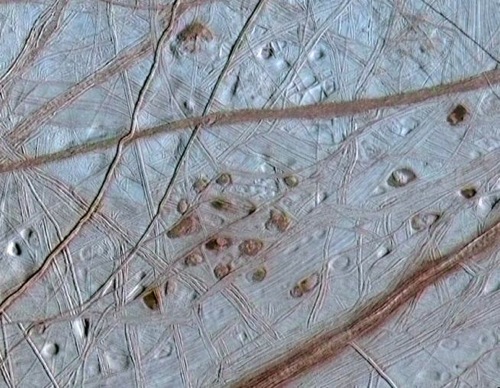
Red spots and pits pepper this ridged zone on Europa's surface, as seen by the Galileo spacecraft. Each spot, or lenticulae, and pit is about 10km across. Their similar size and spacing suggests that Europa's icy shell may be behaving a bit like a lava lamp, with warmer ice moving up from the bottom of the ice shell and colder ice near the surface sinking down. Image: NASA/JPL/University of Arizona/University of Colorado.
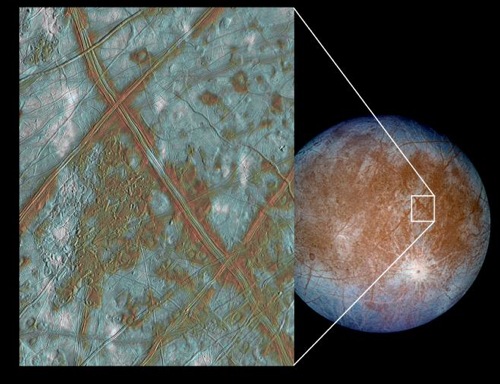
The cracks and ridges criss-cross the entire Europan surface, with reddy-brown areas representing material that has 'leaked' out onto the surface from below. The white zones in this image are fresh rays of ice and other material that was ejected from a large impact crater in the south (see global view). The dark blue zones represent coarse grained ice and the light blue zones represent fine grained ice. Image: NASA/JPL/University of Arizona.
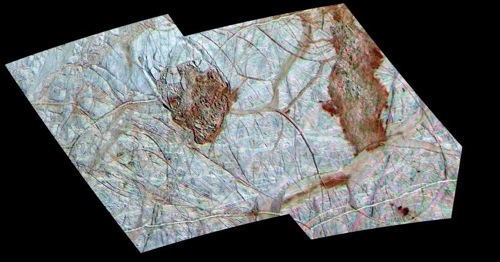
Thera (left) and Thrace (right) are two dark, reddish regions of enigmatic terrain that disrupt the older icy ridged plains on Jupiter's moon Europa. Thera is about 70 km wide by 85 km high and appears to lie slightly below the level of the surrounding plains. Some bright icy plates appear to be dislodged from the edges of the chaos region and curved fractures along its boundaries suggest that collapse may have been involved in Thera's formation. In contrast, Thrace is longer, shows a hummocky texture, and appears to stand at or slightly above the older surrounding bright plains. One model for the formation of these and other chaos regions on Europa is complete melt-through of the icy shell from an ocean below. Another model is that warm ice welled up from below and caused partial melting and disruption of the surface. Image: NASA/JPL/University of Arizona.
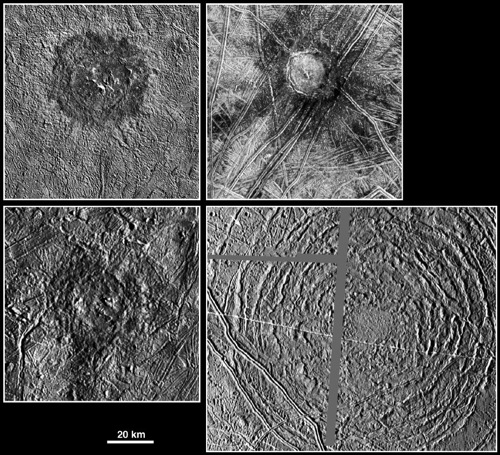
Four impact craters on Europa's icy surface. Clockwise, from top left are Pwyll, Cilix, Tyre and Mannann'an. Over time, the ice surface 'relaxes' and craters appear to be erased from the moon. Some scientists think that Tyre crater, which is 40km across, punctured right through the icy crust into a less brittle layer. The other three craters resemble craters on Ganymede and Callisto suggesting that they formed in thinner ice, or the impacting body was smaller and weaker than in the case of Tyre. Image: NASA/JPL/DLR.
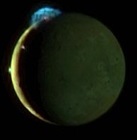 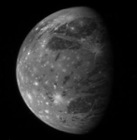
« Previous Next »
|

